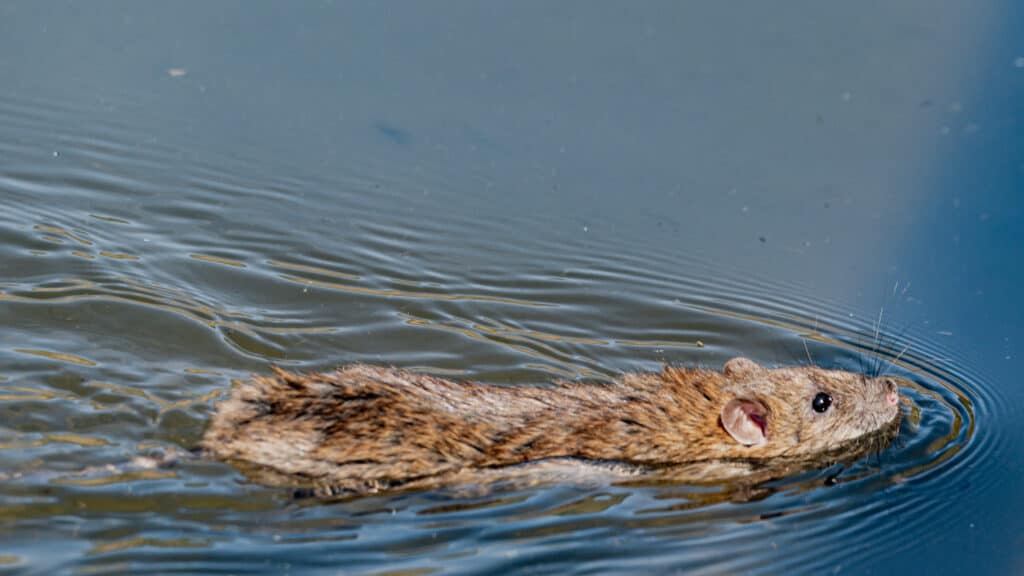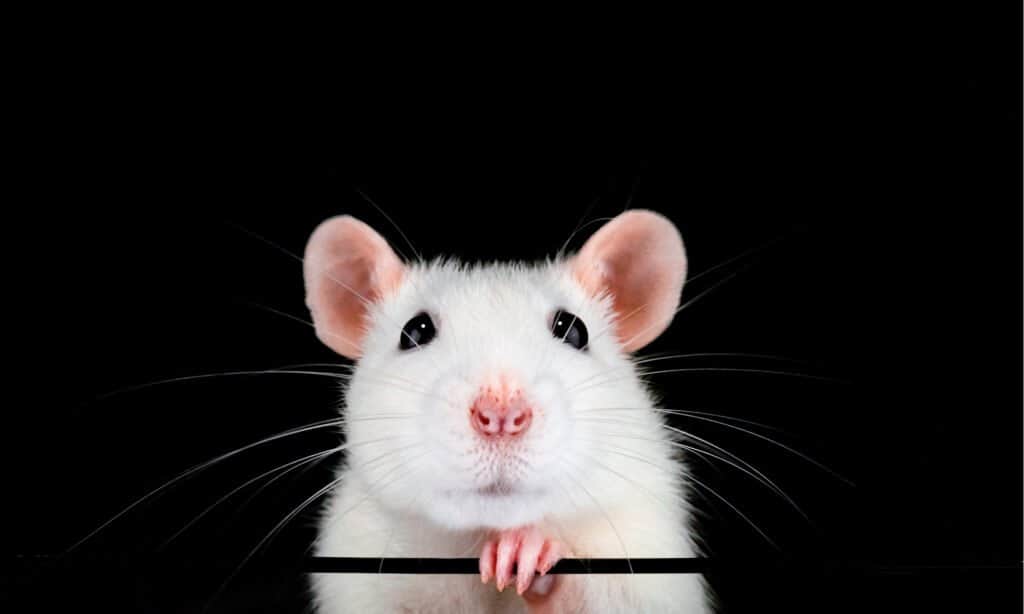Rats populate almost every continent and are as common as people, which means there is one rat for every person on the planet. Because of their ability to thrive, rats have become one of the most successful animal species on earth. Rodents have even been the reason for multiple pandemics that wiped out millions of people in previous centuries. In addition, rats have the uncanny potential to adapt to living in almost any situation and circumstance. Whether living in the wild, on a garbage dump, or in our homes, rodents are expert survivalists, but people often ask, can rats swim?
Can Rats Really Swim?

Rats are excellent swimmers who can hold their breath for almost three minutes and swim underwater.
©iStock.com/Andi Edwards
Although rats are land mammals and prefer dry land, they are excellent swimmers who can hold their breath for almost three minutes and swim underwater. Many species also enjoy swimming, including roof and Norway rats, who learn to swim early in life.
Their bodies are well-equipped for swimming as they have strong legs which help them tread water. A streamlined body also aids them in cutting faster through the water. Rats also use their tails for buoyancy, and their fur traps air when they submerge themselves in water, adding further buoyancy and keeping them warm.
In the wild, some species of rats swim to escape predators and look for food. Impressively, rats have been recorded swimming over a mile and can swim and tread water for up to three days. In addition, rats in urban and suburban areas swim and are familiar with swimming through sewers.
Do Pet Rats Like The Water?
The Norway rat enjoys swimming in its natural habitat and is also known as the brown rat. If you have Norway rats as a pet, they will probably love being in the water. But not all rats like water. Their species and personalities determine their preferences for dry land or swimming, even if all rats can swim.
If you want to test your pet rat’s liking for water and swimming, you should introduce it slowly to a shallow body of water. For starters, you can fill a bowl with water and place it near your rat. It will likely enjoy swimming if it climbs into the container or starts splashing in the water.
So, if you want to give your pet rat the chance to swim, slowly introduce it to deeper bodies of water. If you throw your pet rat in the deep end, and it cannot touch the bottom, it could end up drowning.
What’s the Furthest Distance a Rat Has Swum?

In 2005, a rat swam the distance of over 1,300 feet from the island of Motuhorapapa to Otata Island.
©iStock.com/Philippe Paternolli
One documented case of a long-distance swim by a rat was when it swam across the ocean in New Zealand. In 2005, a rat swam the distance of over 1,300 feet from the island of Motuhorapapa to Otata Island. Researchers recorded this feat and found that this is how rats invade small islands across our oceans.
People have also observed how rats swim across the Volga River to reach Russia. In addition, some rats travel more than a mile away from their nests because they use nearby water sources. These observations mean that rats can swim for long distances without drowning or getting tired.
Are Rats Able To Enter the Home Through the Toilet?
Although uncommon, rats can swim underwater and through plumbing to enter your home. Even though this achievement sounds impossible, a 2015 National Geographic video found that rats can swim through the plumbing and up a toilet to enter a home. Rats can even enter your home by swimming through drainpipes. This activity is impressive and cute if you are a rat lover, but it can be dangerous as rats are known to carry diseases.
Common diseases carried by rats are leptospirosis, salmonella, and hantavirus. But rats entering your home through the plumbing or drainpipes are not that common. Instead, they prefer a more straightforward route, such as entering houses through holes or cracks in the structure. If you suspect a rat issue in your home, you should contact pest control to deal with the problem.
The Size of Rats

Norway rats grow 16 inches in length and weigh between half a pound and one pound.
©JaklZdenek/Shutterstock.com
There is a common perception that some rats can grow to the size of house cats. Although some species of rats are larger than others, rats growing to be the size of house cats is not accurate. For example, the Norway rat grows 16 inches in length and weighs between half a pound and one pound. Roof rats grow to between 13 to 15 inches and weigh 0.3 to 0.6 pounds. Male rats, known as bucks, are larger and heavier than females, which are known as does.
The smallest rat species is Osgood’s Vietnamese rat. This rat grows to roughly 5 or 7 inches long. The largest rat species on the planet is the Sumatran Bamboo rat, which reaches an impressive length of 20 inches.
The Lifespan Of Rats
A rat can reach an average age of two years, which applies to wild and domesticated species. But, some pet rats can live for six to seven years, depending on their surroundings and diet. However, wild rats rarely reach this old age as they have to fight predators and deadly environmental factors.
Getting a Pet Rat

A pet rat is an intelligent and friendly companion.
©Linda Bestwick/Shutterstock.com
Before you choose to get a pet rat, there are a few factors to consider. Rats are nocturnal, which means their cage needs a quiet space during the day. Rats should also not be exposed to other curious house pets. The rat may feel threatened, leading to health issues and high-stress levels. You should also buy toys and treats for your pet rat to chew, which helps them control their teeth size. Rats’ teeth do not stop growing, so they need to gnaw and chew on things to keep their teeth short.
The photo featured at the top of this post is © iStock.com/Philippe Paternolli
Thank you for reading! Have some feedback for us? Contact the AZ Animals editorial team.







